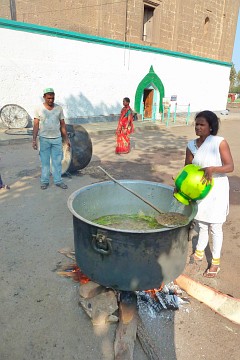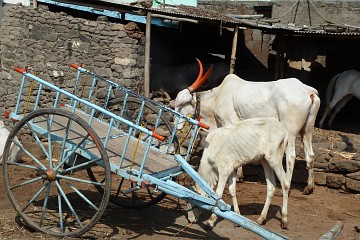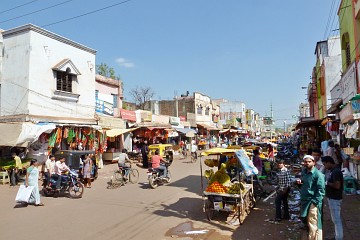Karnataka 2013
(vero;2016-April-15)
Karnataka was a very nice surprise and one of the highlights of our Nindia13 trip. We visited Hampi and the northern part of the state and swore to come back for more when we left, which we did in 2015. We have selected some pictures for our Karnataka photo gallery and you can also read our mail from 04 Feb 2013 for more details of our stay in this fabulous region.
We caught our first glimpse of Karnataka when we arrived from Aurangabad in Bijapur after a bumpy ride in a local night bus. The easy pace of life in this dusty town was all we needed to recover. The town has many islamic monuments: some beautiful mosques, fortified walls and many grand tombs. We stayed three days, taking our time, soaking up the laid-back atmosphere. As it happened, the muslim community was celebrating Eid Milad un Nabi, commemorating the birth of the Prophet. Tools and means of work in shops or on the street (rickshaws and buses) were decorated with flowers, families were out and about, children enjoying themselves on the fair grounds with balloons and crackers. Around the tombs of Jod Gumbad, people were busy cooking food for 2000 in five huge pots, each one containing 100 kilos rice and 50 kilos goat meat for the perfect Biryani.
The day after, it happened to be Republic Day, an other day of celebration. We were woken up with military music at 7am but the whole was a rather low key affair: a bit of flag waving, some kind of parade in the municipal stadium, and clearly not so festive as the day before. But there were many people around, many indian tourists, so the town monuments were crowded and the markets very lively.
From Bijapur, we took a train to Badami. This is more a village than a town but happened to be also in the midst of celebrations: a hindu festival this time, which brought many happy and colourful pilgrims to the place. The landscape is peaceful and beautiful, red hills surrounding the lake and the carved caves, with the sound of women batting their washing in the lake echoing through the site. Many pigs wander around the village lanes, cows are being bathed in the lake. The cows were beautiful, as indian cows can be, with their white fell and red or blue painted horns. A nice memory of Badami was meeting a family at the big Shialaya temple on top of the north fort: Sham Shad Begum, aged 34, her two chilren aged 11 and 7, her two brothers and her sister-in-law Raicha, aged 24 were having a nice day out and dancing in front of the temple to the music of their mobile phone! We also used Badami as a base to visit the temples of Aihole, an other must-see of the region.
Hampi
Arriving in Hampi was a bit of a shock: all of sudden, after two weeks without seeing hardly any other Westerner, we landed in a traveller ghetto par excellence, but quite a sweet one in the end. The place is magic, the ruins of a mighty hindu empire at its height from the 15th to the 17th century, all set in a landscape defined by huge boulders scattered around the river and the surrounding hills amidst lush bananas and palm tree plantations. The site is so big that you never have the feeling of being in a crowded place, that is until you come back to the tourist enclave in the evening... Unlike many other temples which we had visited before, we were surprised and pleased to see that many temple carvings and sculptures were depicting more "everyday" scenes, such as dances, warring soldiers, animals, on top of the usual hindu gods. Every evening, we would go to the Virupaksha temple to attend the arti ceremony just before 8pm: the deity is carried through the temple in a procession to the main shrine, where the arti is performed, before being taken back to its cell for the night. One evening, we even had the pleasure to see the temple elephant, Lakshmi, 24 years old, following the procession, kneeling when needed, as humans were doing, very entertaining! We liked it so much that we returned in 2015 and have created a photo gallery dedicated to Hampi.
If you look on a map, Bidar is in the far northeastern corner of Karnataka, at the end of the world. Or so it seemed as we arrived there after a gruelling journey in the local night bus, which took us in 11 hours from Hampi to Bidar. Finding a bus was not simple: there were differing opinions in Hospet concerning the best connection to Bidar: some told us to take a bus to Gulbarga and then change into a second one for Bidar. Eventually, a hectic station manager confirmed that there was also a direct bus, leaving at 9.30 pm, and we could get tickets on the bus, no reservation. We decided to wait for the direct bus and an unsettling wait it was: lights went off in the bus station as the hours ticked, no one could tell us on which platform the bus would come, we saw buses arriving, loading passengers in front of the station, impossible to read their destination as we could not read the script, it was quite stressful. At last, the Bidar bus arrived, one hour late and nearly full. We did not have much time to ponder: it was the matter of get in and go! So we jumped in, secured the remaining seats at the back of the bus and started our journey. The bus was really old, the shock absorbers dead, and the roads deteriorated very quickly as we made our way northwards. Sitting in the back row did not make things better as we could feel every bump. Needless to say that we were very happy to arrive! Bidar boasts an impressive fort and some nice tombs and madrasas a few kilometres to the east but wandering around the streets, one got the feeling that this town had really been forgotten by the Karnataka government: many streets were not paved, the electricity supply quite sporadic with many power cuts. We stayed three days and it was obvious that the people in Bidar did not see many Westerners, they were much more reserved as in other towns, and the atmosphere felt a bit subdued, as if life was not easy in this part of the world: people seemed poorer, there were not many smiles on their faces. But we were glad we made the effort, and if you are tempted to go there from Hampi, go for the Gulbarga connection (avoid the direct bus) and plan 2 days max, this is amply sufficient.
If you want to read more about Karnataka, check our report from 2015, when we returned and visited Mysore and the temples of the Western Plateau: Belur, Halebid and Shravana Belagola.
And don't forget to check our Karnataka photo gallery
Want to read more? Go back to Meeting People or go on to Quintessential Indian Railways or go up to Blog
$ updated from: Blog.htxt Mon 28 Apr 2025 14:55:30 trvl2 — Copyright © 2025 Vero and Thomas Lauer unless otherwise stated | All rights reserved $






